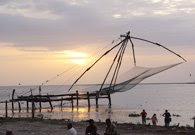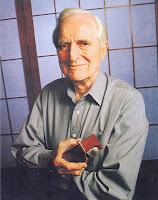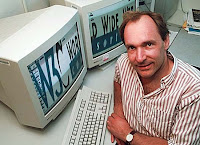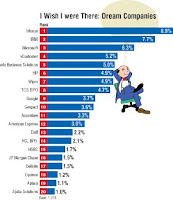Getting to meet and interact with people from diverse cultures and different regions are certainly one of the biggest perks of being a journalist. People take time out for you, indulge you, talk, explain and often entertain you. You are not considered a hindrance and oft times are awarded warm welcomes. So when Dataquest decide to come out with an issue on emerging cities (later renamed as Future Cities) of India from the IT perspective, I was all excited. I got a great chance to visit cities like Kochi, Trivandrum, Nagpur and Vadodara. I met with people from different companies, from a scientist at BARC in Vadodara to VP from Lord Krishna Bank in Kochi to IT head at Haldiram in Nagpur.
Over a fortnight, I was travelling to all these cities and trying to create a true picture, finding out what makes the cities tick, what are the problems faced and what are the advantages that companies like Infosys, TCS or even IBM have from moving to cities like these. It was an enriching experience, as there was so much that I got to learn from so many people I met. Herein I am putting up the first three profiles of the places I visited. A small disclaimer; the pieces here might differ from the actual ones published due to numerous reasons like sharp editing or paucity of space. I would be putting up a post on my experiences in my personal blog (zewak.blogspot.com) soon enough. The three cities follow:
——————————————————————————
Kochi: Now the God’s have IT
The idyllic coastal township is set for big things, as now is banking on IT for them.
“Azim Premji is not only one of the richest Indian but also the toughest Indian to convince,” quips Girish Babu. He must know well because as the former CEO of Infopark, and COO of IT parks, Kerala; Babu was trying hard to convince Wipro to set up base in God’s own country. The sprawling Infopark had been operational in Kochi for year or two and a few entrepreneurs had taken space. But there could not be a better endorsement than Wipro and Babu was well aware of it.
Meanwhile, Wipro had also checked out Coimbatore and company officials were keen for a more developed and investor friendly Tamil Nadu over scenic but labor-issues ridden Kerala.
After much hard lobbying, Wipro set a condition; whichever state gives the company SEZ status first, will get the investment. Babu got cracking and within a day or two was ready with the letter and sent it across to the company. It was in September 2004 that Wipro acquired some 25 acres land and set up operations in the Infopark. “With Wipro much of the perception problem associated with Kerala was solved to a great extent and the gates were open for fresh new investments,” reminisces Babu.
Indeed post 2004, Kochi has literally donned new robes. A trip down the port city and one will be amazed at the frenetic activity all round; big billboards featuring Malayalam stars Mohanlal, Mamooty and even Hema Malini, lord over the cityscape. Newspapers are fully of adverts of upcoming luxurious residential projects all over. There is not a single global brand that would be missed at the malls lining the Marine Drive. Kochi, the commercial capital of Kerala, is shining bright much like the hundred of Alapatt and Alukkas gold showrooms spread all over.
A case of infrastructure
From back in the middle ages, Kochi had been a centre for trade and commerce. The port city had traders flocking in from Manchuria to Persia and beyond. It was a simmering pot of cultures and leisure, coaxing a Chinese traveler to comment that “If China is the place where you earn money, Kochi is the place to spend it”. When the Portuguese under the leadership of Vasco Da Gama were shunted out of Kozhikode (Calicut), they landed up in Kochi and set up the first European factory or trading post.
Post independence, Kochi lost the race for industrialization and the economy more or less stagnated even though the big companies were indeed present. “It was indeed ironical, as Cochin always was more progressive of the cities in all of Kerala. There was the prosperous port and refinery company and of course the Cochin Shipyard, the largest ship building facility in India. Yet the city did not much benefit from all these companies,” says MV Paul, deputy director (Systems), Cochin Port Trust.
all of Kerala. There was the prosperous port and refinery company and of course the Cochin Shipyard, the largest ship building facility in India. Yet the city did not much benefit from all these companies,” says MV Paul, deputy director (Systems), Cochin Port Trust.
Yet, Kochi maintains its lead in terms of physical infrastructure and can give any Tier II city a run for its money in terms of infrastructure. The city has a very reliable power supply, with close to 7 power stations in the vicinity feeding power to the city. There is also no shortage of water supply thanks to the Kadambariar river. And the best of all is the International Airport at Nedumbasserry, the first privately built airport in India. Today there are close to 450 landings every week at the airport and was the only airport in India where the Airbus A380 could land.
Close to the airport in Kakkanad, around 25 kms from the city centre, i.e., Ernakulam, are the upcoming IT hubs. The infrastructure is indeed mind-boggling, there are the broad 4-lanes roads and small landscaped gardens at the roundabouts and of course the imposing glass towers. Except for Infopark, there are new IT parks coming up from L&T, Leela, Muthoothu, and of course the SmartCity by a Dubai based conglomerate.
Little wonder, post Wipro, now TCS has also set up shop in the city. Infosys has agreed for investing in Technopark in Kerala and is also considering at some sort of investment in Kochi as well. According to a Nasscom report, Kochi is best suited for BPO, both voice and non-voice. Currently, ACS and Sutherland have big investment in the Infopark and the way they are expanding, the investment seems to be working. “Currently Kochi accounts for around Rs. 1000 crore of IT exports annually, it will overtake Trivandrum in sometime,” says Babu.
Doubly connected
Kochi is only the city in the country that is the landing point for both SEA-ME-ME3 (it lands in Mumbai) and SAFE undersea cables that connect the country to rest of the globe. Also, gigabyte router of VSNL gateway lies in the vicinity. Because of this unique characteristic, Kochi is always connected, and also best suited for voice based services due to less loss of time due to latency.
“Kochi is the best city in terms of bandwidth connection, as around 80% of Indian traffic is routed through the VSNL gateway. We are very bullish about the prospect of the city and keen to develop IT across the state through the hub and spoke model, where small centres will mushroom around bigger ones like Kochi and Trivandrum,” concurs KR Jyothilal, special secretary, Department of IT, Kerala.
The genteel Malayalee
If that was not good enough to convince people, there is of course the amazing manpower story from Kerala, the first state that was cent percent literate. Kerala also has the distinction of having the largest pool of English speaking manpower and the highest density of IT professionals. The world may have painted a sordid and a combative picture of a Malayalee that is constantly waving the red flag of protest.
But the reality is much in contrast. Thanks to decades of working in other more developed markets in the UAE and US, the modern Malayalee has a more global outlook that any of his up country cousins. Not only is he (or she) well aware of market dynamics but quite willing to inculcate the values of the service industry. Visit any hotel in the city and you will understand the change. The hammer and sickle are best left to the politicians while every one else seems to be pursuing the good ol’ Gandhi or even Monsieur Washington.
As Kochi is just a few hours away from Bangalore, much of the Malayalee professionals that had shifted to the city due to lack of opportunity are quite willing to head back home. Babu talks of how companies in Kochi realized that they had more walk-ins when they advertised the job openings in Bangalore and Hyderabad rather than in Kochi itself. And thanks to the many colleges in the vicinity there is also the abundance of raw talent. “One should hire the employee for his aptitude and train him for his talent. The professionals of this city have the best aptitude, thanks to it being a commercial city that one can find in Kerala or even in South India” says S Venkataraman, deputy director, Lord Krishna Bank (now Centurion Bank).
Red fears
While all may seem outwardly fine, there is indeed a lurking fear in the minds of players in Kochi about the future potential of the city, especially the flip-flop between the Congress and the Communist. While the government officials may argue that investment climate is not affected by change of governments. There does seem to be an ever-so-slight slowdown. Take the case of the SmartCity project, it was riled in controversy in Kerala, while both Karnataka and Andhra Pradesh were ready to offer concessions for the project to shift.
“Kochi has as good as a potential as Hyderabad or even Chennai. We have suffered because of lack of political will. Kerala had a head start over the others when we started with Technopark and yet we have lagged. It is a matter of leadership not ideology as even West Bengal is doing well even though it has been ruled by communists for decades. We are really praying for a good leader,” says Benley Noronha, managing director, Nortech Infonet.
For Ajith Brahmanandan, state information officer, NIC (Lakshwadweep), it is a matter of infrastructure and bad planning. “If you travel through the city of Kochi, especially through Ernakulam, what strikes one is the woe-full planning. In fact, there is no plan at all for the city even though it continues to burst at the seams with people and more people. The government really needs to pay attention to the basic infrastructure,” he says.
Jyothilal dismisses these concerns and terms them as teething troubles. “It is all perception. Even though the governments have kept changing, the policies have not deviated. Today the investment climate is independent of politics and everyone understands the value of IT. That is one of the reasons why the CM himself handles the IT portfolio. Even his son and so many other politicians children are working in the IT industry,” he states.
Whatever is the case of the political front. One thing is certain, Kochi is surely the place to be, if you are not already there. From the time Monsieur Da Gama landed (and subsequently died as well) in Kochi, the city has had a whole lots of firsts, be it the first territory to be colonized, the first state to join Indian dominion, the first to have a private airport, etc. the list just keeps going on. The idyllic backwaters, the scenic sea front and of course the innumerable getaways in close vicinity, makes Kochi a tempting place to shift. The reality market is really booming and everyday counts. After all if the one of richest man (supposedly the smartest as well) in India endorses the city, there is little that can really go wrong. Can it?
**EOM**
Nagpur: From Oranges to IT
Zeroing on the Zero Mile City of India
“What else can you get except oranges?” a friend of mine commented, before I set out for Nagpur. The “What else” really baffled me, indeed, come to think of it; there isn’t much that one associates the city with, except the citrus fruit.
With much apprehension, I landed at Dr. Ambedkar airport, only to find chaotic construction all around. There was much frenzy in the air and one could discern quite a few construction cranes in the foreground and the constant din that one associates with them. Five minutes out of the Airport and a first timer like me is bound to be taken aback by the physical infrastructure, the 4-lane concrete roads and the daunting flyovers. It is very unlike any Tier III (or even tier II) city that you will see in India. And that is biggest irony.
Nagpur, the second capital of Maharashtra is the largest city in central India. Located practically at the centre of India, India’s geographical centre (Zero Mile) passes through the city. Thus every distance in India is measured with Nagpur as the starting point. In fact, for quite sometime (to be precise, since the British times) there have been talks of making Nagpur the second capital of India due to its strategic location. Certainly, the infrastructure is worthy of a capital city.
The strength of infrastructure
According to a recent study conducted by UK-based estate consultants Knight Frank, among a host of other cities, Nagpur is ranked at number 1 in terms of physical infrastructure, at par with Chandigarh and ahead of other cities like Vishakapatinam, Jaipur, Kochi, Goa, and others. This is quite a vindication for a city that has largely been untouched by rapid economic developments made elsewhere in the country.
The city is also well connected both by road and railways to different parts of the country. In fact due to its location, Nagpur is the transit point for all the trains that connect the country lengthwise and breadth wise. The city is also connected by air to all the major airports and  now even has international flights connecting the city globally. And if that was not enough, with the launch of Multi-modal International Hub Airport at Nagpur (MIHAN) in 2002-03, the city is truly become an important transit location not only nationally, but also for the sub-continent. But more on that later.
now even has international flights connecting the city globally. And if that was not enough, with the launch of Multi-modal International Hub Airport at Nagpur (MIHAN) in 2002-03, the city is truly become an important transit location not only nationally, but also for the sub-continent. But more on that later.
The city also had a robust power supply till quite recently. In fact, it had been a power surplus city before the government decided to divert the power to more economic zones like Mumbai and Pune. As of now, there are a couple of hours of planned load-shedding on a daily basis. The residents are agitating against the diversion of power; if they succeed Nagpur will indeed be power surplus again.
An Industrial hub
Spread over an area of 250 sq. km., Nagpur was one of the first cities in India that embraced industrialization. Way back in 1877, Tata’s started the country’s first textile mill, the Central India Spinning and Weaving Company Ltd., in Nagpur. Since then, the city has been the centre of commerce in the Vidarbha region and currently is a large trading centre for a number of commodities and services. A large number of industries are located in Butibori industial area that lies in vicinity of Nagpur. Similarly, there are quite many companies like Mahindra & Mahindra, NECO, Bajaj Auto, Vicco Laboratories, etc. are present in the Hingna industial estate on the western fringes of the city.
IT companies are also waking up to the potential offered by Nagpur, namely in terms of good infrastructure, abundant and cheap labor pool and of course the SEZs. Already a number of companies have taken up space in Nagpur, like Satyam Computer Services and L&T is setting up an Infocity.“Much of the IT business in Nagpur is driven by these companies. There are a few companies that are based in Nagpur and hence local players are benefited. Till few years back not many hardware vendors had a presence in Nagpur but that had changed dramatically. Today every company from IBM to HCL has a representative in the city. Even Microsoft has come here officially and grown by over 900% last year alone,” says Vinod Verma, CEO, Key Computers. “Also the fact that there is no other major city in 300-400 km radius helps the case of Nagpur,” he adds.
One of the major buyers in the region is Indian Air Force that is head-quartered in Nagpur and spends close to Rs. 2-3 crore annually on IT.
MIHAN effect
Nonetheless, every one in Nagpur seems to be talking of just one thing, MIHAN. Go to any software company or an IT vendor, or even some one who is not related to IT at all, he or she would not only know the complete details of MIHAN, but will also rattle of statistics to prove that it is indeed the best thing that could have happened to the city. Not surprisingly, after decades of neglect Nagpur has finally got a project that it deserves and that too the biggest infrastructure project in India.
Taking a chapter right out of China, the government of India is beefing up Nagpur as a major hub. So around the airport over 2000 hectares of land has been earmarked for the MIHAN project. The government agencies are ensuring that this project is of global quality, thus the construction is high grade and so are all the other amenities, right from bandwidth availability to medical facilities. Little wonder, major companies like Satyam Infotech, GE, DLF, Shapoorji Pallonji, L&T Infotech, Patni Computers and Microsoft have taken up large parcels of land in the SEZ within the project. And that is not all; TCS has also announced setting up of 5000-seater facility in Nagpur. Even MNCs like IBM and Dell has taken up space in Nagpur.
“MIHAN is going to completely change the face of the city. It has been the biggest thing to have happened and all of the players within the city as well as outside it are keenly awaiting its completion,” says Malathi Swaminath, managing director, Zeta Softech. An entrepreneur who set-up shop in Nagpur quite few years back, Swaminath is quite bullish about the prospects of the city and has even taken up space in the project.
Costing around Rs. 3500 per sq. feet, MIHAN does indeed make great sense, especially considering the facilities and the amenities that are provided. “MIHAN makes a lot of sense for sense for IT companies that want to set up shop in Nagpur in a big way. Not only is it cost-effective but as the colleges and residential area is in close proximity, there will not be a shortage of manpower to companies working out of it,” says Rakesh Agarwal, CEO, Mayur Computers.
A scientific hub
That brings us to another big plus point of Nagpur, its educational prowess. Over the years largely due to the presence of innumerable engineering government companies, Nagpur has emerged as a scientific and engineering hub. The city is the home to a number of national level scientific and governmental establishments like the National Environmental Engineering and Research Institute (NEERI), Central Institute of Cotton Research (CICR), National Research Centre for Citrus, National Bureau of Soil Survey and Land Use Planning (NBSS–LUP), Jawaharlal Nehru National Aluminium Research and Development Centre, the Indian Bureau of Mines, India’s Intellectual Property Training Institute, the National Academy of Direct Taxes, the Chief Controller of Explosives of the Petroleum and Explosives Safety Organisation, and the South Central Zone Cultural Centre in addition to a regional office of the Indian Meteorological Department.
The city also has several reputed engineering colleges like the Visvesvaraya National Institute of Technology (VNIT), Priyadarshini College of Engineering, Yeshwantrao Chavan College of Engineering, Ramdeobaba Kamla Nehru Engineering College, Laxminarayan Institute of Technology (LIT), G.H. Raisoni College of Engineering, as well as several reputed public as well as private colleges like Dr. Ambedkar College and others. According to an industry player, VNIT has recently set up a nano-technology center in Nagpur, one of five in all of India.
“Nagpur biggest strength is its educational institutes. With around 18 engineering colleges in and around the city, there is a steady flow of workforce. The big problem was that till now there was not much opportunity for these people. But that is changing and as benefits from MIHAN and other projects percolate, Nagpur will see reverse brain drain. All the Nagpur citizens that had to leave the city earlier, will surely flock back,” says Chandrahas Chaudhari, technical head (Business Services), ADCC.
“At the very core Nagpur people are very nice and chilled out; they seldom like to settle down in other cities. Also they are very dedicated and the attrition rate is almost marginal,” adds Swaminath. She was born and raised in Mumbai and settled in Nagpur post marriage, but now prefers the city over the hustle-bustle of big metro like Mumbai.
“Nagpur has all the makings of an IT hub, but sadly it has not been the case. According to me the city is very well suited for high-end R&D and has one of the best engineering graduates that you can find anywhere in the country. The only problem is that it gets a tad to hot in the summers,” says AK Maji, director (Acting), NBSS-LUP.
For far too long Nagpur has been a victim of political machinations. The region (Vidharbha) has been wanting to separate from the state of Maharashtra, which does not want to let go because of the immense natural wealth (remember Chota-Nagpur mining belt). The city has dragged along almost valiantly, been relegated to secondary status within the state.
But all that seems to be changing now and those huge cranes near the airport are laboring towards a new morrow. Nagpur’s time seems to have come to reclaim its rightful position under the sun. So next time, someone asks you “what else” in context to Nagpur. Don’t dwell on it much and ask him to get a new perspective because very soon oranges will have to find a new place as all the orchards would be replaced by campuses and IDCs.
***EOM***
Vadodara: Rise of culture
Dewang Mehta and Sam Pitroda, the two people who single handedly changed the face of Indian IT and telecom, found their bearings in Vadodara
It is a common Indian practice to associate cities with individuals. And the more famous and more numerous celebrities a city can boast, the more it’s snob value. So MK Gandhi is intricately linked with Porbandar and Rabindranath Tagore is associated with Kolkatta, Dhirubhai Ambani with Jamnagar. In more contemporary context, Amitabh Bachchan and Allahabad go hand in hand, while Sachin Tendulkar represents Mumbai, so on.
Going by this logic, Baroda, or Vadodara, should be termed as cradle of Indian IT & telecom, as two of its denizens single handedly changed the face of Indian industry. The first one, Dewang Mehta (born in Umreth, on the border with Anand district) to Indian IT to the world and brought the world to Indian IT. The late president of Nasscom was the public face of Indian IT. Meanwhile, Satyanarayan Gangaram Pitroda or popularly known as Sam Pitroda found his bearings in Vadodara, while pursuing his Masters in Physics and Electronics from Maharaja Sayajirao University. The current chairman of Knowledge Commission and the CEO of C-SAM, is hailed as the father of the PCO and the precursor to telecom revolution.
Yet, the city of Vadodara has largely been untouched by the magic of technology. While the government over the years has actively promoted Surat, Ahemadabad and Gandhinagar; Vadodara has been largely ignored. Ask any citizen and he was look at you askance, no one really seems to have an answer as to why things went the way, they went.
Industrial behemoth
It is quite baffling, considering that the city was at the very forefront of industrial revolution at the turn of the twentieth century. The first modern factory (Alembic Pharmaceuticals) was established in Vadodara in 1907 and subsequently companies like Sarabhai Chemicals, and Jyoti came up in the 1940s. Steadily over the years, Vadodara became a hub for chemicals and textile industry.
If that was not enough, in the late sixties, oil and gas companies made a beeline for Vadodara. Out of the blue, Vadodara was a host to companies like Gujarat Refinery, Indian Oil Corporation. Discovery of oil and gas in Ankleshwar led to rapid development of the city. Even ONGC and GAIL set up there centers in the outskirts of the city. Followed by the oil and gas majors, fertilizers and chemical major like Gujarat State Fertilisers & Chemicals (GSFC), Indian Petrochemicals Corporation Limited (IPCL, Reliance) and Gujarat Alkalies and Chemicals Limited (GACL) also set up shop in the region. By the eighties, the city was brimming with activity, and there was a vibrant SMB sector.
T hat was before the recession set in. Over the next many years, the city stuck by economic gloom. As the whole Gujarat state went downhill on the economic parameters, so did Vadodara. In the nineties, the situation was so bad that a lot of the SMBs had to shut shop or ship out. That was quite the case till the Modi government came in power in the State after which much of the recession was arrested and subsequently reversed. While Vadodara might not have gained from the boom, it certainly did not stagnate.
hat was before the recession set in. Over the next many years, the city stuck by economic gloom. As the whole Gujarat state went downhill on the economic parameters, so did Vadodara. In the nineties, the situation was so bad that a lot of the SMBs had to shut shop or ship out. That was quite the case till the Modi government came in power in the State after which much of the recession was arrested and subsequently reversed. While Vadodara might not have gained from the boom, it certainly did not stagnate.
From industry to IT
The tide might be turning, or at least there are some signs that it could. There has been an awakening of sorts in regards to the use of IT. Pharma and oil majors had driven much of IT adoption in Vadodara, as they happen to be big users of IT. But much of this equipment is either sourced directly from the computer vendors, for instance, ONGC extensively uses Silicon Graphic machines, thus the local channel community is not really benefited. Of course the servicing and the peripherals industry is flourishing in the city.
Many companies are now keen to exploit the vast talent pool that is available in the city. In a recent report released by CII, “Vadodara: Knowledge City”, stated that the city is attracting a large number of investors to create infrastructure for IT and related companies. “Vadodara has a great potential to develop as an IT hub on account of its large English-speaking population and low cost of living. There are at least three IT parks coming up in Vadodara district. We are also considering to offer land of Gujarat Communications & Electronics and another 17 acre site of defunct Priyalakshmi Mill in the heart of the city,” said Raj Kumar, secretary, department of science and technology of government of Gujarat and MD of Gujarat Informatics. According to him, large presence of IT parks and big banners of IT industry would be visible in the next couple of years in the city.
While L&T plans to come up with an IT zone near Vadodara, many more IT parks are also in the offing, in fact Nipium Infotech is planning IT park in association with the Singapore government at the cost of around Rs. 500 crore and is waiting for an approval. There have also been reports that HCL intend to set up operation around the city. Even Pitroda’s C-SAM has a development center in Vadodara.
“Vadodara is fast emerging as a favored destination for companies looking for cost-effective operations and trained manpower. Vadodara might now have highly skilled people available as of now, but that is bound to change as more and more firms set up operations here,” said Yogesh Thakkar, CEO, Rhythm Electronics – one of the leading channel players in the city.
Over a dozen new IT and BPO companies have started operations in the city over the last many years. MNCs are also entering the city through the M&A route, CSC recently acquired local player CSC that provides high-end BPO services from Vadodara center. There is also InteQ IT Services India that operates out of Vadodara and provides RIM services to US clients.
Much of the companies that operate out of Vadodara are 300-500 seaters. Though the biggies are coming in the small way, as of now, TCS has a 200-seater facility in Vadodara, set up especially to work with Gujarat State Electricity Board. “There are a few call centers in city like Fortune Infonet and others. Slowly and steadily Vadodara is catching up as an investment destination. When Dewang Mehta was alive he used to push the city. Sadly after his death, there was not much action,” says Nilesh Kuvadia, CEO, IT Consultancy Group. Kuvadia is also a member of the Baroda Information Technology Group (BITG). BITG currently has around 350 members and has been active for the last 9 years.
A computer savvy city
Like any other smaller city, the biggest asset of Vadodara is the workforce. Thanks to the numerous colleges like Sardar Patel University, Sigma Institute of Management Studies, Parul Institute of Engineering and Technology, and of course MS University, ensures there is a steady stream of well-educated youth flowing into the marketplace year-after-year. “Vadodara’s biggest strength is its well-educated talent pool from the only English-medium University of the state and growing private sector educational institutions. The quality of education is as good as those available at high-tech institutes like IIT Roorkee,” says Indranil Deb, manager (Program), ONGC.
Deb also vouches for the high computer literacy in Vadodara. “The people are very computer savvy and you can find even small-time chemists doing their accountancy on computers. Even in the late 80s, there were students here that were taking up courses on C and C++. The product of Vadodara is as good as any other that you will find in the country,” he states. Currently ONGC operates a high-end Virtual Reality center in Vadodara.
Naresh Kumar Garg, senior scientific officer, BARC, also underscores the same point. “To be honest, over the last many years a lot of amazing work has been done on the e-governance front, especially the computerization of land records. This has led to high computer literacy. Personally, the way Vadodara Municipal Corporation has also gone in for automation is a feat by itself,” he says.
“This city is a heaven for outsiders as the culture is very cosmopolitan, yet not really commercial. I have been in this city for the past 19 years, and cannot think of anywhere else that I rather be,” adds Garg.
Indebted to his highness
Vadodara has a nickname, Sayaji Nagari, it is quite an apt one. Any discussion on Vadodara cannot be completed without mentioning the name of former ruler of the state, Maharaja Sayajirao Gaekwad III, who ruled the state from 1881 to 1939. The visionary ruler is responsible for all that Vadodara has to offer, even today. He was a reformist, and on assuming the power, made primary education free and compulsory, banned child marriages, encouraged fine arts, among other achievements. Maharaja founded Bank of Baroda in 1908 and also University of Vadodara, aptly named after him. To get a glimpse of the amazing personality, visit the Maharaja Fatesingh Musuem, located in the Laxmi Vilas Palace Compound and houses one of the best personal art collection in all of India.
“The Maharaja was so ahead of his time that he had created a man-made reservoir in Ajwa that would take care of the water needs of the city for the next 2 centuries and it is very much doing so,” says Deb.
Situated some 40 minutes (air) away from Mumbai. Vadodara is ideal location for back-office and BPO work. As of now, the real estate prices have not peaked and this makes the city an ideal candidate for investment. The only possible drawback is probably prohibition policy. Thus, after a hard day, you cannot really chill out with a beer or two. Other than that, it is city that really showcases all that is good in a small town-city of India, be it culture or its warm people. It is quite hard not to be in love with Vadodara, as it is unique in so many ways and therein lies it biggest charm. The city does not really need celebrities to associate with it, as every citizen is a ardent supporter.
***
 Take the case of a laptop display screen, in all these years; it has remained much as it was.
Take the case of a laptop display screen, in all these years; it has remained much as it was. for applications such as large area sensor networks, lightweight viewing screens for various handheld devices like PDAs, etc. Philips last year displayed a device with a rollable display known as Readius, that is fairly similar in design but quite different in the way it is manufactured. “My work could help enable a practical printing process for generating flexible display technologies,” says Maliakal.
for applications such as large area sensor networks, lightweight viewing screens for various handheld devices like PDAs, etc. Philips last year displayed a device with a rollable display known as Readius, that is fairly similar in design but quite different in the way it is manufactured. “My work could help enable a practical printing process for generating flexible display technologies,” says Maliakal.
























